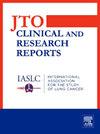A Retrospective Observational Cohort Study of Lung Cancer Screening Outcomes Among U.S. Blacks and Whites
IF 3.5
Q2 ONCOLOGY
引用次数: 0
Abstract
Background
Mortality from lung cancer is reduced with low-dose computed tomography (LDCT) screening in high-risk persons. But screening uptake is low, especially among Black persons. Previous reports of LDCT had low participation of Black persons, which may inhibit wider adoption. In this study, we report on outcomes of LDCT screening in Black and White cohorts.
Methods
Retrospective observational cohort study using concurrent data from LDCT screening and tumor registries to compare the results of LDCT efficacy in reducing stage 4 lung cancer presentations in Black and White participant cohorts.
Results
Blacks comprised 13% of the 3647 unique eligible LDCT participants who had at least one LDCT. No statistically significant differences in LDCT category 4 were noted after screening. Lung cancers were diagnosed in 16 out of 466 (3.4%) Black LDCT participants and in 119 out of 3181 (3.7%) White LDCT participants. Black LDCT screening participants were 5.4 times less likely to be diagnosed with stage 4 lung cancers if diagnosed through screening compared to “usual care” (13% versus 44%, p <0.02). White LDCT participants were 3.5 times less likely to present with stage 4 lung cancer if diagnosed through screening compared to usual care (13% versus 35%, p < 0.0001).
Conclusions
LDCT reduced the number of stage 4 presentations in both cohorts. These findings should encourage attempts to increase LDCT utilization in all populations.
美国黑人和白人肺癌筛查结果的回顾性观察队列研究
背景:对高危人群进行低剂量计算机断层扫描(LDCT)可降低肺癌死亡率。但筛查的接受程度很低,尤其是在黑人中。以前的LDCT报告中黑人的参与率很低,这可能会阻碍更广泛的采用。在这项研究中,我们报告了黑人和白人队列中LDCT筛查的结果。方法回顾性观察队列研究,使用来自LDCT筛查和肿瘤登记的并发数据,比较LDCT在减少黑人和白人参与者队列中4期肺癌发病的疗效。结果:在3647名至少有一次LDCT的独特合格LDCT参与者中,黑人占13%。筛查后LDCT第4类差异无统计学意义。466名黑人LDCT参与者中有16名(3.4%)被诊断出肺癌,3181名白人LDCT参与者中有119名(3.7%)被诊断出肺癌。如果通过筛查被诊断为4期肺癌,与“常规护理”相比,黑人LDCT筛查参与者被诊断为4期肺癌的可能性低5.4倍(13%对44%,p <0.02)。与常规护理相比,白人LDCT参与者通过筛查诊断为4期肺癌的可能性低3.5倍(13%对35%,p < 0.0001)。结论:sldct减少了两组患者的4期发病次数。这些发现应该鼓励在所有人群中增加LDCT的利用。
本文章由计算机程序翻译,如有差异,请以英文原文为准。
求助全文
约1分钟内获得全文
求助全文
来源期刊

JTO Clinical and Research Reports
Medicine-Oncology
CiteScore
4.20
自引率
0.00%
发文量
145
审稿时长
19 weeks
 求助内容:
求助内容: 应助结果提醒方式:
应助结果提醒方式:


